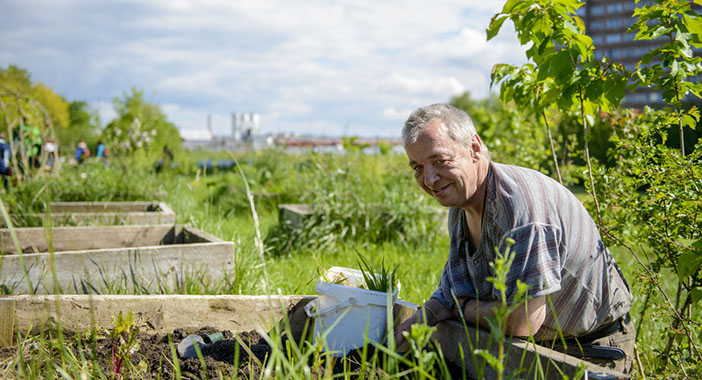Getting our towns climate-ready with blue and green infrastructure

To introduce our Climate Action Towns work, we asked partners across Scotland to write about how Scotland’s towns can address climate change. Here Deryck Irving of the Green Action Trust explores how we can use green space and manage water to make our towns climate-ready.
Frequently, when considering a relatively new and unfamiliar concept, it is easier to define what it is not rather than what it is. ‘Climate action towns’ may be a case in point.
So, what is a Climate INACTION Town?
It is dominated by cars and traffic. Roads, parking and other ‘car infrastructure’ make it difficult and unpleasant to move around and discourage people from spending any more time than necessary in the town centre. Air pollution is a major problem anywhere that traffic slows: especially in the most built-up areas of the town where pollutant levels concentrate between buildings.
The town’s carbon footprint is high. Transport is heavily based on fossil fuels and buildings are heated in the winter and cooled in the summer. People choose to drive to town, even for short journeys, or go elsewhere to shop. They drive long distances to get to out-of-town shopping or to other towns and cities with a better ‘offer’.
The town is hard and grey. Surfaces are sealed, leading to flash flooding whenever there is heavy rainfall. This is because water flows off buildings and streets too fast for the combined drains and sewers to cope.
Streets have no shade, making them unpleasantly hot during warm, dry spells. Homes, shops, and offices are increasingly having to use fans and air conditioning to keep temperatures at a comfortable level.
People have settled for a ‘business-as-usual’ approach. They have not changed behaviours in response to global and national ambitions because it is ‘too difficult, overwhelming or confusing’, ‘someone else will deal with it’ or they feel personally and collectively disempowered.
Sound familiar? This clearly presents an extreme example, but all of these are real issues that occur in some combination in Scotland’s towns.
Low-carbon, climate-ready places where people want to be
How can blue and green infrastructure contribute to the future success of our towns as low carbon, climate-ready places where people want to be?
Greener streets and local greenspaces make urban areas more attractive and pleasant to spend time in, with an associated increase in the use of shops and local facilities. They provide recreational and relaxing places for people working and living locally.
These spaces, particularly where they include street trees, wooded areas, and green walls, make surrounding areas cooler and improve air quality.
Sustainable surface water management features such as rain gardens in streets and public spaces reduce flood risk from extreme rainfall events, often more cheaply than traditional solutions.
Green roofs on buildings help with water management. They also reduce the need to heat and cool buildings.
Active travel routes through and between towns reduce our reliance on cars and make it easier to walk, cycle or wheel around.
Greenspaces can support local food growing, both community and commercial, creating a stronger and more resilient food economy.
Pre-installing green infrastructure, including surface water management, active travel connections and renewable energy generation, opens up areas for other uses. It also generates the development of vacant and derelict land.
An additional benefit is the empowerment of local businesses and communities. Blue and green infrastructure projects can often be developed and delivered by communities themselves.
What more can we gain from our towns being climate-ready places?
This is not just about carbon savings or reducing flood risk. There are many other starting points and rationales which will match with local placemaking and economic development priorities.
For example, towns might prioritise green tourism and look to maximise biodiversity and walking or cycling. Post-industrial towns might choose to prioritise tackling vacant and derelict land as a mechanism for providing blue and green infrastructure and improving quality of place.
Towns that act as dormitory settlements for our major cities might focus on creating attractive, green places and local digital hubs to support home-working and reduce the need to commute. They might couple this with enhanced EV, active travel and public transport infrastructure for those who still travel to work.
About Green Action Trust
Green Action Trust is Scotland’s leading environmental regeneration charity and supports towns in their journey in tackling the climate emergency. It works in conjunction with local businesses, community organisations and councils and is environmental partner for Scotland’s Towns Partnership. It supports a wide range of potential actions to match locally agreed priorities, but its primary interest and expertise is in improving the blue and green infrastructure in Scotland’s towns.
For more information on the Green Action Trust and how it can help your town in becoming a climate-ready place, contact Deryck Irving, Director of Strategy and Development at deryck.irving@greenactiontrust.org
Header image credit: Marc Millar
Share your place-based climate action
We would like to hear from communities and local authorities who are creating carbon conscious places. If you are designing and adapting a place to reduce, repurpose and absorb carbon, please share examples of your work with us.
